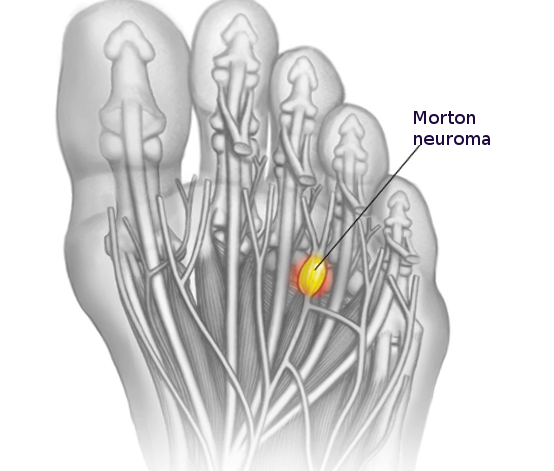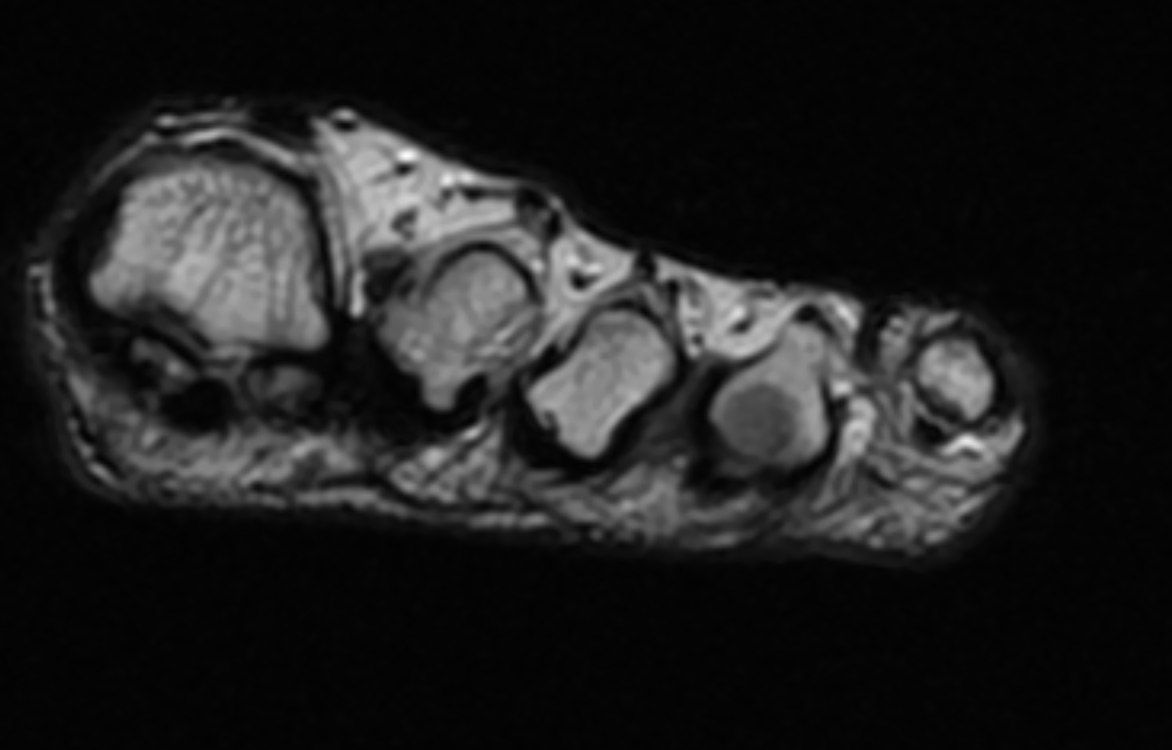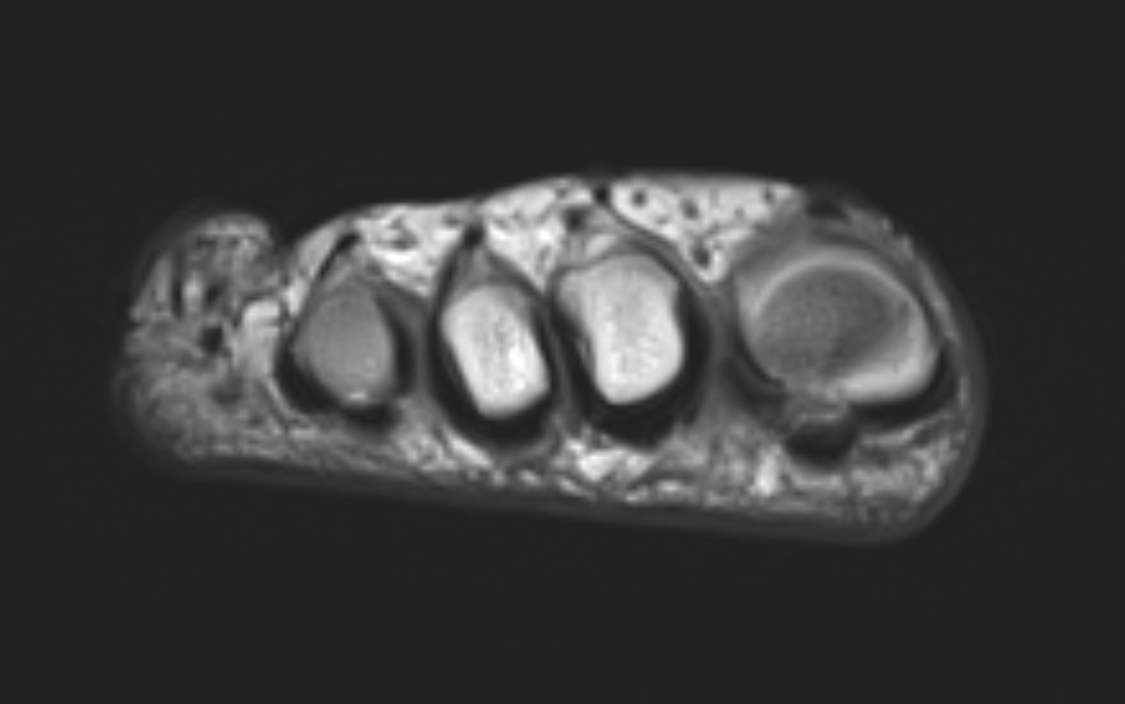[1]
Ruiz Santiago F,Prados Olleta N,Tomás Muñoz P,Guzmán Álvarez L,Martínez Martínez A, Short term comparison between blind and ultrasound guided injection in morton neuroma. European radiology. 2018 Jul 31
[PubMed PMID: 30062527]
[2]
Ganguly A,Warner J,Aniq H, Central Metatarsalgia and Walking on Pebbles: Beyond Morton Neuroma. AJR. American journal of roentgenology. 2018 Apr
[PubMed PMID: 29470159]
[3]
Lorenzon P,Rettore C, Mechanical Metatarsalgia as a Risk Factor for Relapse of Morton's Neuroma After Ultrasound-Guided Alcohol Injection. The Journal of foot and ankle surgery : official publication of the American College of Foot and Ankle Surgeons. 2018 Sep - Oct
[PubMed PMID: 29779991]
[4]
Kim JY,Choi JH,Park J,Wang J,Lee I, An anatomical study of Morton's interdigital neuroma: the relationship between the occurring site and the deep transverse metatarsal ligament (DTML). Foot
[PubMed PMID: 17880876]
[5]
Bossley CJ,Cairney PC, The intermetatarsophalangeal bursa--its significance in Morton's metatarsalgia. The Journal of bone and joint surgery. British volume. 1980 May;
[PubMed PMID: 7364832]
[6]
NISSEN KI, Plantar digital neuritis; Morton's metatarsalgia. The Journal of bone and joint surgery. British volume. 1948 Feb;
[PubMed PMID: 18864949]
[7]
Di Caprio F,Meringolo R,Shehab Eddine M,Ponziani L, Morton's interdigital neuroma of the foot: A literature review. Foot and ankle surgery : official journal of the European Society of Foot and Ankle Surgeons. 2018 Apr
[PubMed PMID: 29409221]
[8]
Edenfield KM,Michaudet C,Nicolette GW,Carek PJ, Foot and Ankle Conditions: Midfoot and Forefoot Conditions. FP essentials. 2018 Feb
[PubMed PMID: 29381043]
[9]
Santiago FR,Muñoz PT,Pryest P,Martínez AM,Olleta NP, Role of imaging methods in diagnosis and treatment of Morton's neuroma. World journal of radiology. 2018 Sep 28
[PubMed PMID: 30310543]
[10]
LiMarzi GM,Scherer KF,Richardson ML,Warden DR 4th,Wasyliw CW,Porrino JA,Pettis CR,Lewis G,Mason CC,Bancroft LW, CT and MR Imaging of the Postoperative Ankle and Foot. Radiographics : a review publication of the Radiological Society of North America, Inc. 2016 Oct
[PubMed PMID: 27726748]
[11]
Naraghi R,Bremner A,Slack-Smith L,Bryant A, The relationship between foot posture index, ankle equinus, body mass index and intermetatarsal neuroma. Journal of foot and ankle research. 2016
[PubMed PMID: 27980684]
[13]
Mak MS,Chowdhury R,Johnson R, Morton's neuroma: review of anatomy, pathomechanism, and imaging. Clinical radiology. 2021 Mar;
[PubMed PMID: 33168237]
[14]
Naraghi R,Bremner A,Slack-Smith L,Bryant A, Radiographic Analysis of Feet With and Without Morton's Neuroma. Foot
[PubMed PMID: 27837053]
[15]
Masala S,Cuzzolino A,Morini M,Raguso M,Fiori R, Ultrasound-Guided Percutaneous Radiofrequency for the Treatment of Morton's Neuroma. Cardiovascular and interventional radiology. 2018 Jan
[PubMed PMID: 28956110]
[16]
Lizano-Díez X,Ginés-Cespedosa A,Alentorn-Geli E,Pérez-Prieto D,González-Lucena G,Gamba C,de Zabala S,Solano-López A,Rigol-Ramón P, Corticosteroid Injection for the Treatment of Morton's Neuroma: A Prospective, Double-Blinded, Randomized, Placebo-Controlled Trial. Foot
[PubMed PMID: 28617064]
Level 1 (high-level) evidence
[17]
Mischitz M,Zeitlinger S,Mischlinger J,Rab M, Nerve decompression according to A.L. Dellon in Morton's neuroma - A retrospective analysis. Journal of plastic, reconstructive
[PubMed PMID: 32171681]
Level 2 (mid-level) evidence
[18]
Lee J,Kim J,Lee M,Chu I,Lee S,Gwak H, Morton's Neuroma (Interdigital Neuralgia) Treated with Metatarsal Sliding Osteotomy. Indian journal of orthopaedics. 2017 Nov-Dec
[PubMed PMID: 29200487]
[19]
Rasmussen MR,Kitaoka HB,Patzer GL, Nonoperative treatment of plantar interdigital neuroma with a single corticosteroid injection. Clinical orthopaedics and related research. 1996 May
[PubMed PMID: 8620640]
[20]
Espinosa N,Seybold JD,Jankauskas L,Erschbamer M, Alcohol sclerosing therapy is not an effective treatment for interdigital neuroma. Foot & ankle international. 2011 Jun
[PubMed PMID: 21733418]
[21]
Chemical characterization of isocyanate-protein conjugates., Tse CS,Pesce AJ,, Toxicology and applied pharmacology, 1979 Oct
[PubMed PMID: 16045848]
[22]
Matthews BG,Hurn SE,Harding MP,Henry RA,Ware RS, The effectiveness of non-surgical interventions for common plantar digital compressive neuropathy (Morton's neuroma): a systematic review and meta-analysis. Journal of foot and ankle research. 2019;
[PubMed PMID: 30809275]
Level 1 (high-level) evidence
[23]
Studies on the tissue-disposition and fate of N-[14C]ethyl-N-nitrosourea in mice., Johansson-Brittebo E,Tjälve H,, Toxicology, 1979 Aug
[PubMed PMID: 23851648]
[24]
A method for removing precipitate from ultrathin sections resulting from glutaraldehyde-osmium tetroxide fixation., Ellis EA,Anthony DW,, Stain technology, 1979 Sep
[PubMed PMID: 22134434]
[25]
Effect of phenobarbital on cerebral energy state and metabolism. Enzymatic activities., Benzi G,Agnoli A,Dagani F,Ruggieri S,Villa RF,, Stroke, 1979 Nov-Dec
[PubMed PMID: 19802669]
[26]
Local versus regional procurement and distribution of granulocytes., Friedenberg WR,Marx JJ Jr,Weir GJ,Banerjee TK,Chang S,Becker G,, Transfusion, 1979 Nov-Dec
[PubMed PMID: 18594745]
[28]
Lu VM,Puffer RC,Everson MC,Gilder HE,Burks SS,Spinner RJ, Treating Morton's neuroma by injection, neurolysis, or neurectomy: a systematic review and meta-analysis of pain and satisfaction outcomes. Acta neurochirurgica. 2021 Feb;
[PubMed PMID: 32056015]
Level 1 (high-level) evidence
[29]
Park YH,Jeong SM,Choi GW,Kim HJ, The role of the width of the forefoot in the development of Morton's neuroma. The bone
[PubMed PMID: 28249977]
[31]
Habashy A,Sumarriva G,Treuting RJ, Neurectomy Outcomes in Patients With Morton Neuroma: Comparison of Plantar vs Dorsal Approaches. The Ochsner journal. 2016 Winter
[PubMed PMID: 27999504]
[32]
Bucknall V,Rutherford D,MacDonald D,Shalaby H,McKinley J,Breusch SJ, Outcomes following excision of Morton's interdigital neuroma: a prospective study. The bone
[PubMed PMID: 27694592]



